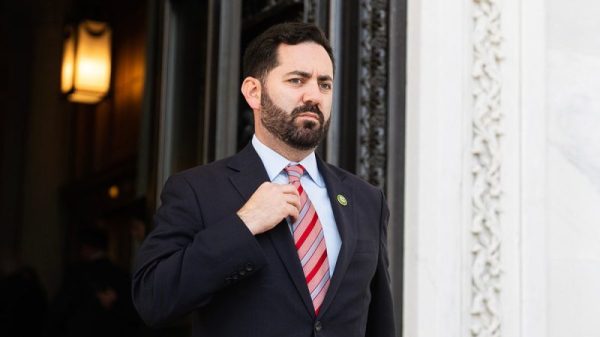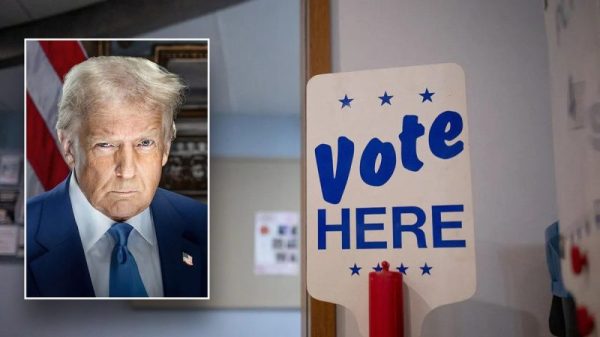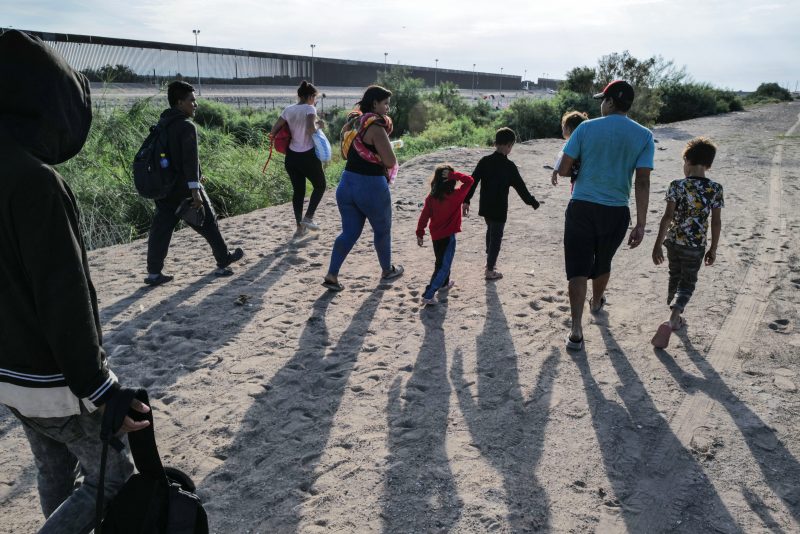In summer 2014, violence in Central America began to prompt migrants, many of them children, to move northward, seeking refuge in the United States. This was an unexpected challenge for the administration of President Barack Obama; that so many of the surge of people arriving at the U.S.-Mexico border were under 18 meant that more stringent rules for housing and processing them applied.
Conservative media took advantage. From July 2013 to June 2014, Fox News mentioned the border at least 5,300 times. In July 2014, the month the crisis peaked, the border was mentioned on Fox News more than 7,100 times. Breitbart, then nearing the height of its influence, stoked concerns about the immigrants bringing Ebola into the country.
Immigration became a central focus of right-wing commentary. After Obama won reelection in 2012, the right briefly flirted with signing on to legislation that would provide a path to citizenship for immigrants. After 2014, though, the potency of a fervent anti-immigration platform with the Republican base became obvious.
Donald Trump understood this. When he announced his candidacy for president in June 2015, he demonized immigrants and made protecting the border a centerpiece of his campaign. Fox News had moved on and Trump’s comments triggered a backlash — but the backlash simply drew attention to his rhetoric and triggered his rise in the polls.
It’s easy to see how this pattern unfolded in retrospect, how Trump’s willingness to parrot the anti-immigration rhetoric prevalent in right-wing media differentiated him from his more cautious, more traditional opponents and positioned him as a “truth teller” on this and other issues. Harder to assess is what happened in 2020 — Trump’s position improved among Hispanic voters, who opposed him robustly in 2016 — and what it suggests about 2024.
The night before President John F. Kennedy was assassinated — 60 years ago Wednesday — he was in Houston at an event hosted by the League of United Latin American Citizens. Kennedy’s campaign has been credited with one of the first targeted efforts at appealing to Hispanic voters, but thanks to strict immigration laws in place at the time, there were relatively few Hispanic voters to court. That year, Hispanics made up 3.5 percent of the population; now, about 1 of every 5 U.S. residents is Hispanic.
This is thanks, in part, to Kennedy. His death triggered enormous goodwill for Democratic leaders and Lyndon B. Johnson, sworn in as president on Air Force One hours after Kennedy’s death. Kennedy’s brothers advocated a bill loosening immigration restrictions, which went into effect in 1965. Immigration, particularly from Mexico, surged.
From 1980 to 2020, the density of Hispanics in the population nearly tripled. On average, counties in the continental United States saw the percentage of their populations that were Hispanic jump from 4.4 percent to 10.5 percent. Big increases in the percentage of Hispanics were seen across the country, in red and blue counties.
This map, however, doesn’t tell the whole story.
Last month, researchers from Tufts University and Loyola University Chicago published an updated analysis of the effects of undocumented migration into the United States. Ernesto Tiburcio and Kara Ross Camarena determined that increases in undocumented immigrants in a county “significantly increases the vote share of the Republican Party in federal elections and decreases total public expenditure.”
Their analysis, considering anonymized data on 8.8 million Mexican nationals living in the United States, looked at elections including the 2014 midterms.
“A one percentage point increase in unauthorized migrants is associated with 6.51 point increase in the share of votes that go to Republicans” in midterm elections, Tiburcio and Ross Camarena wrote. An increase in immigrants at the average, or mean, level leads to “a 3.93 point increase in vote share for Republican candidates” in House midterms while, in presidential years, it is estimated to yield “a 1.61 point increase in vote share for Republican House candidates and a 2.22 point increase for the Republican presidential candidate.”
This may not have had a determinative effect on election outcomes, they note, because the averages may be skewed by bigger shifts in more-Republican places. That said, their analysis suggests that “recent unauthorized Mexican migrants move electoral preferences to the right across the national geography, potentially deciding narrow races.”
Seeing those estimates, one would be forgiven for assuming it meant bad news for President Biden’s reelection bid. After all, there were more than 2.2 million apprehensions made by the Border Patrol last year, up nearly 450 percent from 2020. The relative rate of apprehensions (people stopped between border checkpoints) was 6.6 per 1,000 U.S. residents, the highest since 1986, when there were about 6.7 stops per resident.
But immediately we see the limitations on the estimates noted by Tiburcio and Ross Camarena. In 1986, Democrats gained five seats in the House. In 2022, they lost nine, but overperformed projections.
It’s probably more useful, then, to look at what happened in 2020. Relative to 2016, many of the most densely Hispanic counties in the country moved to the right, offering Trump wider victory margins or narrow losing ones. Those shifts were a function of the most-heavily Hispanic counties casting fewer votes for the Democratic candidate and their casting more votes for Trump relative to the lower-turnout 2016 contest.
Analysis conducted by Equis Labs in the wake of the election offered a convincing theory of what changed: Because immigration was down in 2020 (thanks to the pandemic), immigration lost saliency and Trump spent less time railing about it. Instead, he focused on the economy, where his polling among Hispanics was far better.
One interesting aspect of the shift, though, was that the biggest shifts occurred in certain geographic areas, like South Florida and the counties along the U.S.-Mexico border. Writing for Texas Monthly in September 2021, Jack Herrera explored why counties near the border in that state were more receptive to Trump, finding that Hispanics there were often more established in the United States and differentiated between themselves and Trump’s excoriations of the new arrivals — a group of which they were not a part.
“Hispanic residents of our state are much more likely to identify as White than Hispanic residents of cities elsewhere in the country,” Herrera wrote. “With roots many generations deep in lands that were annexed from Mexican control to that of the U.S., many also actively reject being cast as immigrants.”
On the map at the top of this article, you can see that the relative change in the Hispanic population from 1980 to 2020 was modest in those Texas border counties.
In fact, if we group counties into deciles (that is, 10 buckets) by the increase in the Hispanic percentage of the population from 2010 to 2020 and by the percentage of the county that was Hispanic in 2020, we see that the biggest shifts to the right from 2016 to 2020 were in places with high Hispanic populations but low recent growth — the counties at top right, below.
That upper-right bucket, marking the counties that are at or above the 90th percentile in Hispanic population but below the 10th percentile in change since 2010? They moved to the right an average of 8.5 points in 2020.
Those are also, collectively, relatively populous counties. Nearly 26 million people live in the three groups of counties with the highest population of Hispanics but the three lowest levels of increase since 2010. That’s about as many as live in the counties shown at bottom-right, the ones with the highest Hispanic population and biggest increase since 2010. (Those counties, too, voted more Republican on average.)
One last observation, pulled from my recent book: Hispanic voters in places with less dense Hispanic populations are less likely to be registered as Democrats than Hispanics in more densely Hispanic areas. This is an additional data point in support of the (admittedly non-surprising) idea that assimilation plays a role.
Biden still holds an advantage among Hispanic voters in (very) early 2024 polling. It’s possible that immigration being a more salient issue in 2024 than in 2020, as seems all-but-certain, may boost Biden’s position with some Hispanics (in keeping with Equis’s analysis) while failing to appeal to established Hispanic populations like those documented by Herrera. Non-Hispanic voters, meanwhile, may well be pushed to the right by the sharp increase in immigration in keeping with the research from Tiburcio and Ross Camarena, though that doesn’t seem to have had a significant effect on the 2022 results.
We can probably make two safe assumptions. First, the increase in immigration over the past few years is going to be more of a negative for Biden in a matchup against Trump than a positive. And second, anyone still treating the Hispanic vote as a monolith is going to come to incorrect conclusions about the upcoming presidential contest.


































